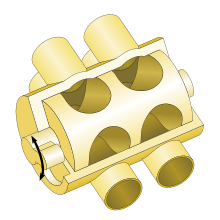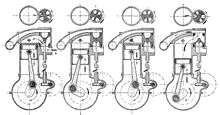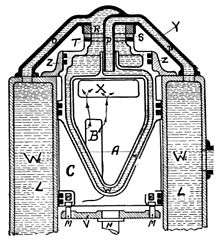Rotary valve

A rotary valve is a type of valve in which the rotation of a passage or passages in a transverse plug regulates the flow of liquid or gas through the attached pipes. The common stopcock is the simplest form of rotary valve. Rotary valves have been applied in numerous applications, including:
- Changing the pitch of brass instruments.
- Controlling the steam and exhaust ports of steam engines, most notably in the Corliss steam engine.
- Periodically reversing the flow of air and fuel across the open hearth furnace.
- Loading sample on chromatography columns.
- Certain types of two-stroke engines.
- Most hydraulic automotive power steering control valves.
Use in brass instruments

In the context of brass instruments, rotary valves are found on horns, trumpets, trombones, flugelhorns, and tubas. Many European trumpet players tend to favor rotary valves.
Trombone F-attachment valves are usually rotary, with several variations on the basic design also in use, such as the Thayer axial-flow valve and Hagmann valve.
Joseph Riedl is credited with the first use of rotary valves on brass instruments in 1832.
Use in industry
In industry, a rotary valve is used to regulate the flow of a product, usually to reduce the flow rate to a level more suitable to the process being undertaken. Typical applications are for feeding a weighed hopper or for feeding a mill that can be clogged by the product.
As part of the material exchange process, the valve is often used as a measuring or metering device.
A rotary valve in the pharmaceutical, chemical and food industry is used to dose and feed solid bulk products within the processes.
Airlock type rotary valve is often used to enter or extract material from two chambers with different pressure level.
Use in engine design


The rotary valve combustion engine possesses several significant advantages over the conventional assemblies, including significantly higher compression ratios and rpm, meaning more power, a much more compact and light-weight cylinder head, and reduced complexity, meaning higher reliability and lower cost. As inlet and exhaust are usually combined special attention should be given to valve cooling to avoid engine knocking.
Rotary valves have been used in several different engine designs. In Britain, the National Engine Company Ltd advertised its rotary valve engine for use in early aircraft, at a time when poppet valves were prone to failure by sticking or burning.[1]
From the 1930s, Frank Aspin developed a design with a rotary valve that rotated on the same axis as the cylinder bore, but with limited success.[2]
Kawasaki and others have also used rotary valves in two-stroke motorcycle engines, where the arrangement helps to prevent reverse flow back into the intake port during the compression stroke.[3]
Austrian engine manufacturer Rotax used rotary intake valves in their now out-of-production 64 hp (48 kW) Rotax 532 two-stroke engine design and continues to use rotary intake valves in the 532's successor, the current-production 64 hp (48 kW) Rotax 582.[4][5]
US company Coates International Ltd has developed a spherical rotary valve for internal combustion engines which replaces the poppet valve system. This particular design is four-stroke, with the rotary valves operated by overhead shafts in lieu of overhead camshafts (i.e. in line with a bank of cylinders). The first sale of such an engine was part of a natural gas engine-generator.[6]
Rotary valves are potentially highly suitable for high-revving engines, such as those used in racing sportscars and F1 racing cars, on which traditional poppet valves with springs can fail due to valve float and spring resonance and where the desmodromic valve gear is too heavy, large in size and too complex to time and design properly. Rotary valves could allow for a more compact and lightweight cylinder head design. They rotate at half engine speed and lack the inertia forces of reciprocating valve mechanisms. This allows for higher engine speeds, offering approximately perhaps 10% more power. The 1980s MGN W12 F1 engine used rotary valves but never raced. Between 2002 and 2004 the Australian developer Bishop Innovation and Mercedes-Ilmor tested rotary valves for a F1 V10 engine.[7]
Bishop Innovations' patent for the rotary valve engine was bought out by BRV Pty Ltd, owned by Tony Wallis, one of the valves original designers. BRV has constructed several functional motors using the rotary valve technology, such as a Honda CRF 450, which had greater torque at both low(17% increase) and high (9% increase) engine speeds, and also produced more brake horsepower up to around 30% more at functional engine speeds.[7] The engine was also considerably smaller and lighter, as the cylinder head assembly was not as large.
A company in the UK called Roton Engine Developments made some progress in 2005 with a 2 rotor (one for inlet and one for exhaust) on a motorcycle single cylinder Husaberg. They filed patents and got an example running in 2006 but were backed by MG Rover who subsequently went bust, leaving Roton without enough funds to continue. The designs surfaced some years later in Australia with Engine Developments Australia Pty Ltd. A prototype casting was produced in 2013 on a Kawasaki Ninja 300 parallel twin unit. This unit is still in development phase at the time of writing but is significant as it has the potential to run much higher compression ratios than even other rotary valve engines due to a significant but undisclosed new cooling method of the combustion chamber and the ability to eliminate the throttle completely, making it vastly more economical at lower engine speeds, so it is claimed.
Use in production engines
UK company RCV Engines Ltd uses rotating cylinder liner technology as a specialized form of rotary valve in some of their four-stroke model engine and small-engine line-up.[8][9] ACV also use horizontal and vertical rotary valves in four-stroke engines in their current range of engines.[10]
RCV have developed a 125cc rotating cylinder liner engine, incorporating a rotating valve in the cylinder liner, for scooter applications.[11] PGO Scooters of Taiwan were working with RCV in developing the engine for their applications.[12]
Use in chromatography
Rotary valves are used for loading samples on columns used for liquid or gas chromatography. The valves used in these methods are usually 6-port, 2-position rotary valves.
See also
References
- ↑ Flight magazine, April 1911
- ↑ Aspin Rotary Valve Engine Accessed on 18th Oct 2010
- ↑ Free engine info Accessed on 18th Oct 2010
- ↑ BRP-Rotax GmbH & Co. KG (2006). "OPERATORS MANUAL FOR ENGINE TYPES 447, 503 & 582" (PDF). Retrieved 4 January 2011.
- ↑ Raisner, William: LEAF catlog, pages 6-105. Leading Edge Airfoils, 1995.
- ↑ Coates International Accessed on 3rd Mar 2011
- 1 2 Wallis, Tony (2007). "The Bishop Rotary Valve" (PDF) (Special ed.). AutoTechnology Magazine. Retrieved 2011-12-26.
- ↑ RCV. "RCV Engines Ltd - UK (India – AutoExpo 2004)" (PDF). Retrieved 2012-01-03.
- ↑ Keith Lawes. "The Rotating Cylinder Valve 4-stroke Engine (SAE Paper 2002-32-1828)" (PDF). Retrieved 2012-01-03.
- ↑ "rcv_engines_ltd". Rcvengines.com. Retrieved 2014-04-18.
- ↑ "Engine Development". RCV Engines. Retrieved 2014-04-18.
- ↑ Jeremy Korzeniewski RSS feed Google+. "PGO working on rotary valve scooter engine". Green.autoblog.com. Retrieved 2014-04-18.